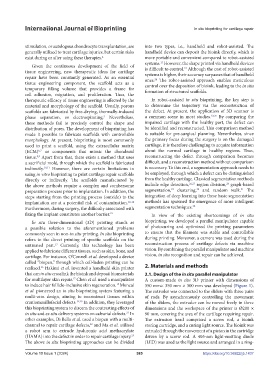Page 393 - IJB-10-1
P. 393
International Journal of Bioprinting In situ bioprinting for cartilage repair
stimulation, or autologous chondrocyte transplantation, are into two types, i.e., handheld and robot-assisted. The
generally utilized to treat cartilage injuries, but certain risks handheld device can deposit the bioink directly, which is
exist during or after using these therapies. more portable and convenient compared to robot-assisted
4
systems. However, the shape printed via handheld devices
13
Given the continuous development of the field of 19
tissue engineering, new therapeutic ideas for cartilage is difficult to control. Although the cost of robot-assisted
systems is higher, their accuracy surpasses that of handheld
repair have been constantly generated. As an essential ones. The robot-assisted approach enables meticulous
24
tissue engineering component, the scaffold acts as a control over the deposition of bioink, leading to the in situ
temporary filling volume that provides a frame for formation of structured scaffolds.
cell adhesion, migration, and proliferation. Thus, the
therapeutic efficacy of tissue engineering is affected by the In robot-assisted in situ bioprinting, the key step is
material and morphology of the scaffold. Usually, porous to determine the trajectory via the reconstruction of
scaffolds are fabricated by free-drying, thermally-induced the defect. At present, the application of 3D scanner is
5
phase separation, or electrospinning. Nevertheless, a common scene in most studies. 23,25 By comparing the
these methods fail to precisely control the shape and impaired cartilage with the healthy part, the defect can
distribution of pores. The development of bioprinting has be identified and reconstructed. This comparison method
made it possible to fabricate scaffolds with controllable is suitable for pre-surgical planning. Nevertheless, since
morphology. At present, bioprinting is most commonly the primary focus during the surgery is on the damaged
used to print a scaffold, using the extracellular matrix cartilage, it is therefore challenging to acquire information
(ECM) or components that mimic the chondroid about the normal cartilage in healthy regions. Thus,
6,7
tissue. Apart from that, there exists a method that uses reconstructing the defect through comparison becomes
8,9
a sacrificial mold, through which the scaffold is fabricated difficult, and a reconstruction method without comparison
indirectly. 10,11 However, there are certain limitations in is necessary. To this end, a segmentation approach needs to
using in vitro bioprinting to print cartilage repair scaffolds be employed, through which a defect can be distinguished
directly or indirectly. The scaffolds manufactured by from the healthy cartilage. Classical segmentation methods
28
the above methods require a complex and cumbersome include edge detection, 26,27 region division, graph-based
31
29
30
preparation process prior to implantation. In addition, the segmentation, clustering, and random walk. The
steps starting from the printing process (outside) to the integration of deep learning into these basic segmentation
implantation are at a potential risk of contamination. 12-14 methods has spawned the emergence of more intelligent
Furthermore, during surgery, the difficulty associated with segmentation techniques. 32
fixing the implant constitutes another barrier. 15 In view of the existing shortcomings of in situ
In situ three-dimensional (3D) printing stands as bioprinting, we developed a parallel manipulator capable
a possible solution to the aforementioned problems of photocuring and optimized the printing parameters
commonly seen in non-in situ printing. In situ bioprinting to ensure that the filament was stable and controllable
refers to the direct printing of specific scaffolds on the during printing. Moreover, a camera was used during the
untreated part. Currently, this technology has been reconstruction process of cartilage defects via machine
13
applied to fabricate different tissues, such as skin, bone, and vision. By combining the parallel manipulator and machine
cartilage. For instance, O’Connell et al. developed a device vision, in situ recognition and repair can be achieved.
called “biopen,” through which cell-laden printing can be
realized. Hakimi et al. invented a handheld skin printer 2. Materials and methods
16
that can in situ crosslink the bioink and deposit biomaterials 2.1. Design of the in situ parallel manipulator
for multilayer skin repair. Chen et al. used a manipulator A custom-made in situ 3D printer with dimensions of
17
to induce hair follicle-inclusive skin regeneration. Moncal 350 mm× 350 mm × 300 mm was developed (Figure 1).
18
et al. pioneered an in situ bioprinting system featuring a The extruder was connected to the sliders with three pairs
multi-arm design, aiming to reconstruct tissues within of rods. By asynchronously controlling the movement
craniomaxillofacial defects. 19,20 In addition, they leveraged of the sliders, the extruder can be moved freely in three
this bioprinting system to discern the contrasting effects of dimensions and the workspace of the printer is Ø200 ×
in situ and ex situ delivery systems on calvarial defects. In 90 mm, covering the area of the cartilage requiring repair.
21
other examples, Di Bella et al. used a biopen with a multi- The extrusion head comprised a screw rod, a bioink
channel to repair cartilage defects, and Ma et al. utilized storing cartridge, and a curing light source. The bioink was
22
a robot arm to extrude hyaluronic acid methacrylate extruded through the movement of a piston in the cartridge
(HAMA) into the defect in order to repair cartilage injury. driven by a screw rod. A 405-nm light-emitting diode
23
The above in situ bioprinting approaches can be divided (LED) was used as the light source and arranged in a ring-
Volume 10 Issue 1 (2024) 385 https://doi.org/10.36922/ijb.1437

